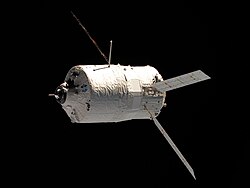Automated Transfer Vehicle
| Description | |
|---|---|
| Role: | Supply the International Space Station with propellant, water, air, payload and experiments. |
| Crew: | None, but human-rated. |
| Dimensions | |
| Height: | 10.3 m (34 ft) |
| Diameter: | 4.5 m (15 ft) |
| Launch Payload: | 7,667 kg (16,903 lb) |
| Return Payload: | None |
| Mass at launch: | 20,750 kg |
| Pressurized Volume: | 48 m3 |
| Electrical Energy | |
| Source: | 4 solar panel wings of 4 panels each and 40Ah rechargeable batteries |
| Size: | total span 22.3 m |
| Generated Power: | 3,800 W |
| On-board engines | |
| Main engine: | 4 × 490N, Aerojet (GenCorp) Model R-4D-11 |
| Thrusters : | 28 × 220N for attitude control & braking, Airbus Lampoldshausen |
| Performance | |
| Endurance: | Docked with the ISS for six months |
| Apogee: | 400 km |
| Perigee: | 300 km |
| Inclination: | 51.6 degrees |
| Launch | |
| Location: |
CNES's Guiana Space Centre, Kourou in French Guiana |
| Site: | ELA-3 |
| Booster: | Ariane 5 |
The Automated Transfer Vehicle, originally Ariane Transfer Vehicle or ATV, was an expendable cargo spacecraft developed by the European Space Agency (ESA). It was operated in conjunction with the Ariane 5 heavy-lift launch vehicle, which conveyed the ATV into orbit.
A total of five ATVs, Jules Verne, Johannes Kepler, Edoardo Amaldi, Albert Einstein, and Georges Lemaître were launched. Following several delays to the programme, the first of these was launched in March 2008. These ATVs performed supply missions to the International Space Station (ISS), transporting various payloads such as propellant, water, air, food, and scientific research equipment; ATVs also reboosted the station into a higher orbit while docked. It was an unmanned platform that operated with a high level of automation, such as its docking sequence; at no point was it used for transporting passengers. On 2 April 2012, the ESA announced that the ATV program would be terminated following the launch of the fifth ATV in 2014.
Further use of the ATV has been proposed. Various further developments, including manned versions of the ATV as well as opportunities to reuse sections or elements of its technology, have been studied by both the ESA and Airbus Defence and Space, the principal manufacturer of the vehicle. In 2012, ESA member states decided that the ATV would be adapted to serve as the service module of the NASA Orion spacecraft. In January 2013, the ESA and NASA announced that they were proceeding with a combined Orion and ATV derived service module, which would serve a major component for the in-development Orion manned spacecraft.
...
Wikipedia

